Is it worth learing to ski in your 40s? I travelled to Switzerland to find out
From beginner jitters to parallel turns - the story of how I learned to ski in Switzerland
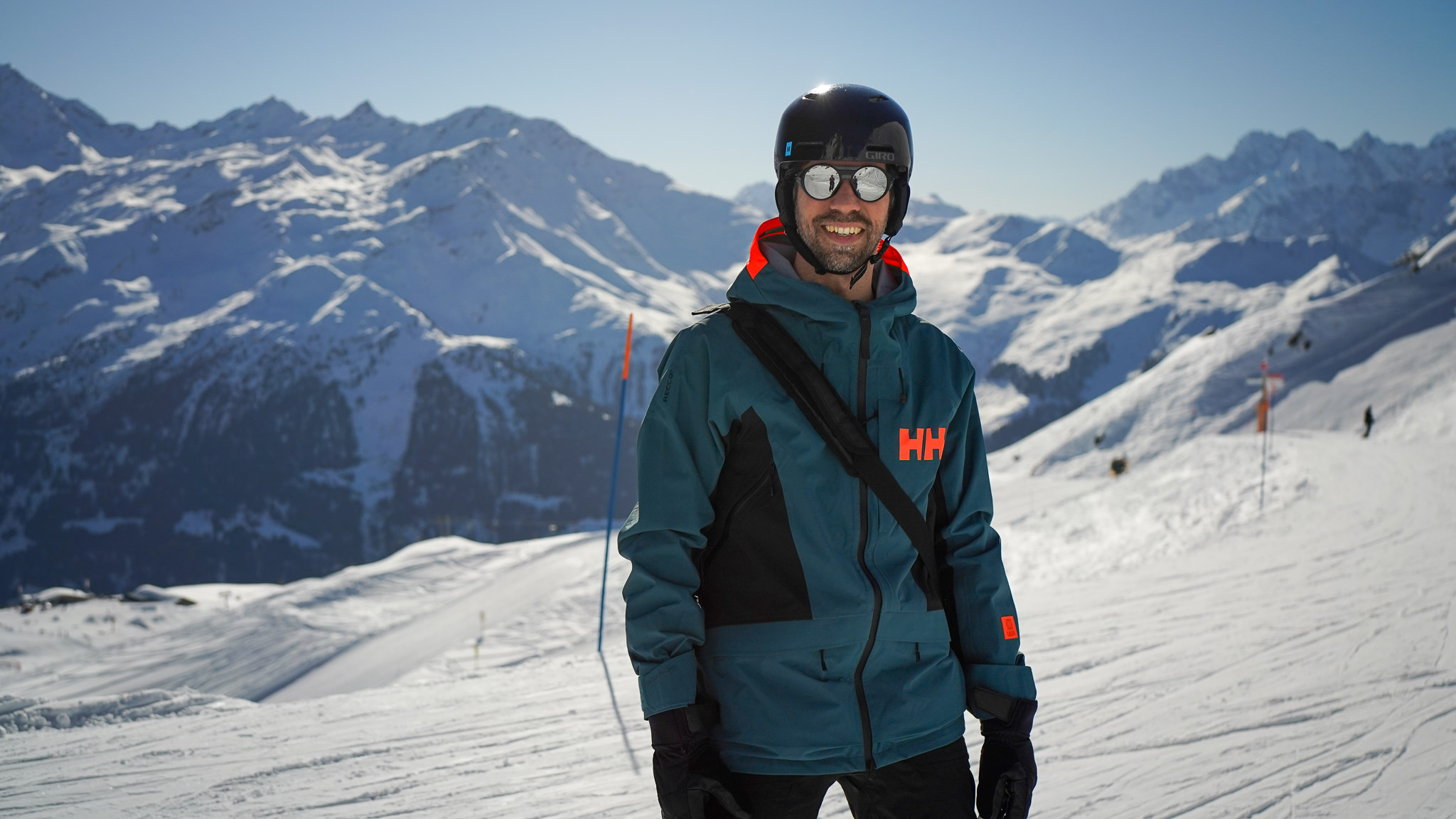
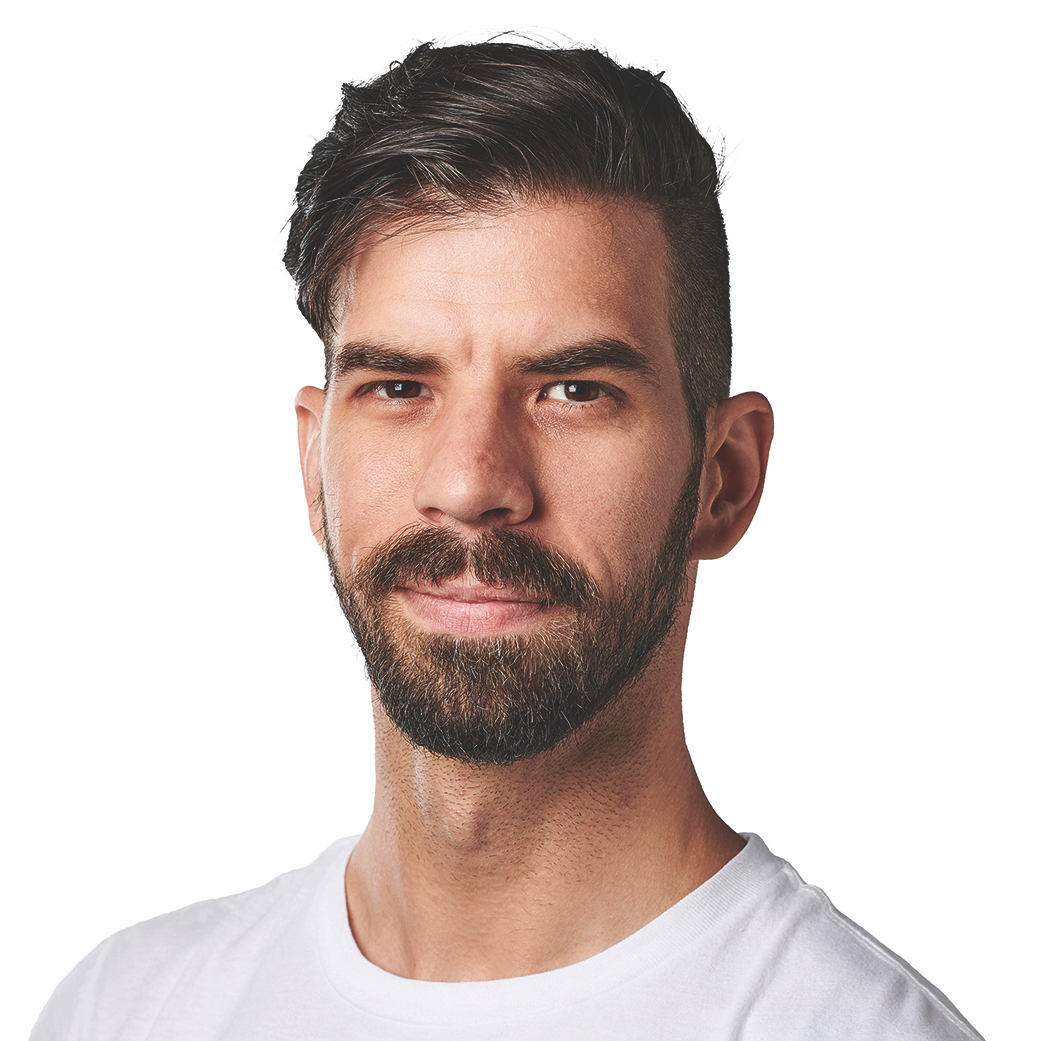
You might think that someone like me, who did everything from 100-mile ultramarathons in Mongolia and bikepacking through Wales to trail running in the Dolomites and eFoiling in the South of England, must have mastered the art of skiing. After all, I turned 40 last year, which is plenty of time to tick something like skiing off the bucket list.
Well, that’s not the case. I’ve never skied before, partially because we never had the money to go on ski trips when I was young, and it hasn’t come up later in life. So imagine my excitement when Helly Hansen approached me with an offer I couldn’t refuse: did I want to learn to ski in Verbier?
Part of the company’s campaign called ‘A World That Needs More Alive’, I was not only taken to Switzerland to get my grips with the beautiful sport that is skiing, but the brand also recruited legendary freeride skier and Helly Hansen ambassador Warren Smith to show me the ropes, which is not dissimilar to getting Michelangelo painting your bathroom.
As well as being pretty good at skiing, Warren also has a Ski Academy in Verbier, which he set up a quarter of a century ago. “We were one of the first foreign ski schools in Verbier, mixing in with a few Swiss schools,” he says. “We’ve built a strong community of regular skiers, and we were also early adopters of video analysis in ski training – filming and analysing technique long before it became common practice.”
The Warren Smith Ski Academy has around 3,000 regular clients and has qualified more than 1,000 ski instructors up until now. “That’s been an incredible achievement for us,” adds Warren. Aside from coaching, he had a professional skiing career as part of the Völkl Freeride Team, participating in product shoots, ski testing, and filming.
Is it possible to go from zero to skiing hero in just three days? One thing was sure: I had no time to waste once I arrived in Verbier. But first, I had to get there.
Day 1
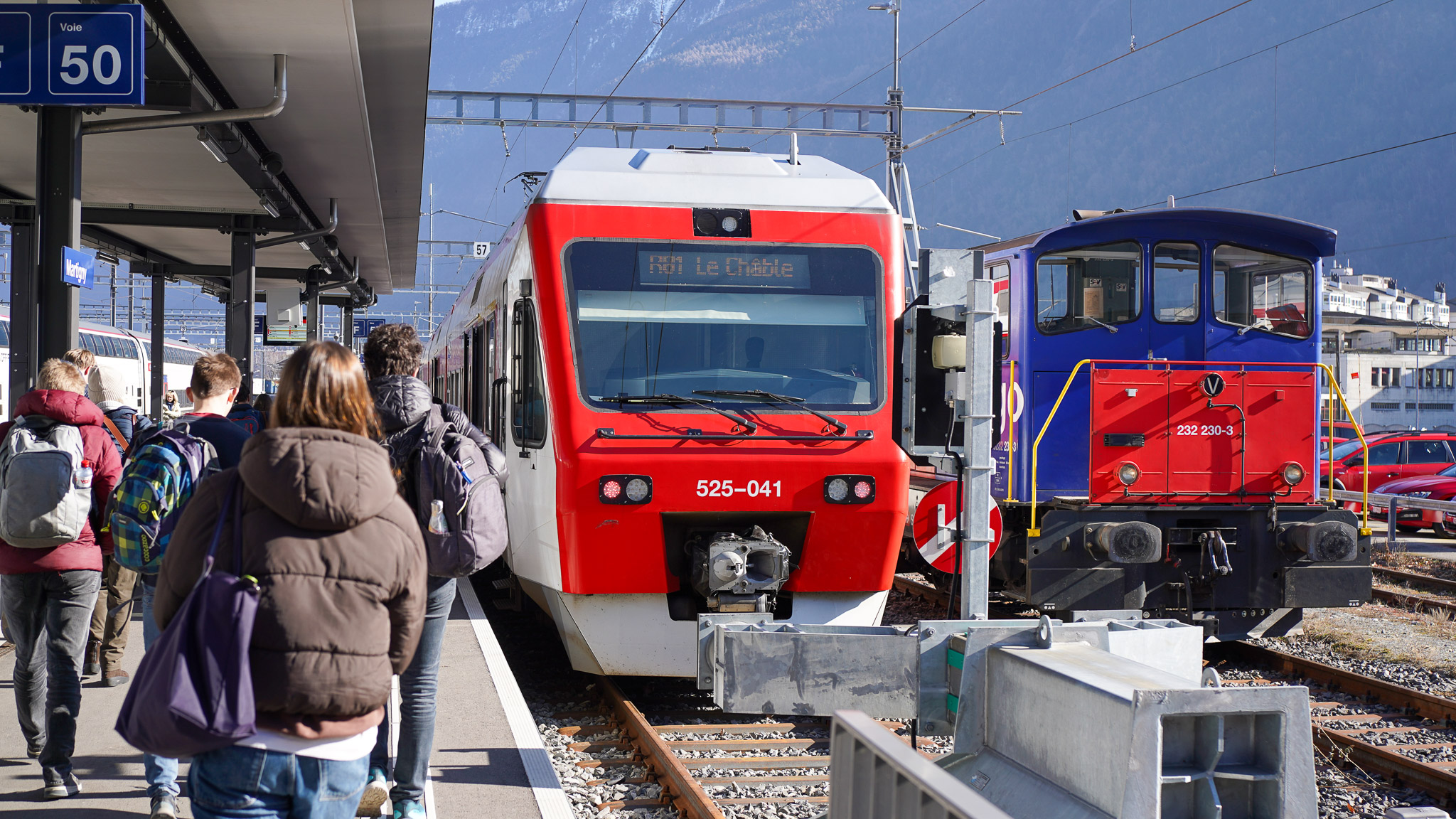
I arrive nice and early at Geneva airport. I need to catch a train, but first, I have to find where the trains are. Switzerland strikes me as a punctual country, so I’m fairly confident I’ll be able to catch my two connections despite connection times as short as four minutes.
Sign up to the T3 newsletter for smarter living straight to your inbox
Get all the latest news, reviews, deals and buying guides on gorgeous tech, home and active products from the T3 experts
The trains aren’t punctual but somehow always on time. The spacious double-decker setup means I have a full four-seater for yourself, my bags, and other bits. The folding tables are neat and clean, and there are sockets and bins - just for me.
The sunshine glistens on Lake Geneva’s crescent body as we travel around it from Geneva airport to Martigny. Looking at Google Maps, the journey seems like an upside-down horseshoe (or a down-facing half-moon). The places we zoom past look like illustrations from a fairy tale. The names are equally enchanting to my ears: Lausanne, Vevey, Montreux, St Mauritz, and Chillon Castle.
The lake disappears from the view as the train’s nose starts pointing south. The sun bathes me in its golden light; haven’t realised I was on the sunny side when I got on at the airport. With Lake Geneva just behind us, the Diablerets appear seemingly out of nowhere. Snow-topped mountains pierce the sky, beautifully terrifying against the backdrop of nearly kept, lush green fields.
Looking at the mountains makes me feel at ease. I have a love affair with the Alps and jump at every opportunity to visit the area. I find it soothing to glance up at the massifs, knowing how small and insignificant we all are. At the same time, I can feel my belly flutter in joy, knowing I’m on my way up. I never had a bad time in the mountains.
The tannoy announces the Martigny stop, telling us that this is the stop to change for Chamonix and, of course, Verbier. I got off and notice people dressed in mountain gear with climbing ropes thrown around their shoulders. Long, hefty bags hiding skis and snowboards are wheeled around. Hard to imagine being able to enjoy winter sports with the sun beating on us right now. Surely, there can’t be any snow in this weather!?
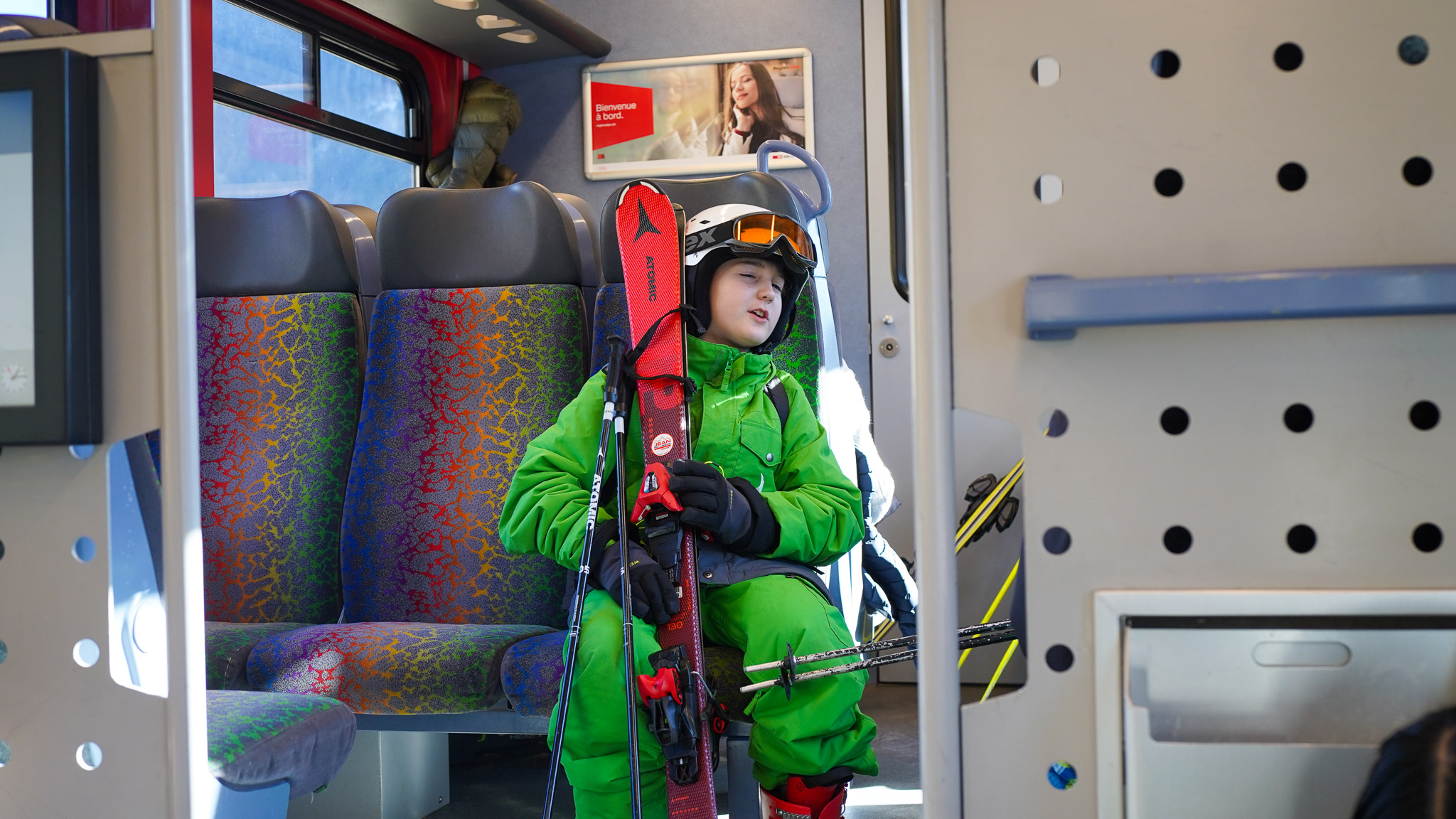
In Martigny-Bourg, a group of what looks like 7-8-year olds get on the train in full ski gear. They click-clack on the hard floor of the train in their ski boots, clutching their skies and poles and wearing their helmets. French chitter-chatter fills the carriage. I feel an odd sense of gratefulness for them; I wish I had the opportunity to try skiing when I was this young. Alas, I’m just about to embark on my first skiing experience at the ripe age of 40.
After Martigny-Bourg, the weather turns. We’re at the foot of the mountain, on the shady side. The slender, tall trees are covered in frost. Thanks to the heating and the bodies surrounding me, I still feel hot on the train in my Helly Hansen fleece.
The snow takes over at Sembrancher. We must be at altitude; not quite the Himalayas, but high enough for snow not to melt. The sun keeps shining relentlessly, filling the carriage with warmth and light. Someone gets off in shorts and sneakers. The weather app says it’s 6 degrees Celsius outside. Hard to imagine with all the snow everywhere.
In La Chable, I say goodbye to my tiny friends. I leap off the train and jog around the train station to catch my connection. The bus driver doesn’t speak English, so we use the international hand sign code to point at things and give a thumbs up to communicate. I hope I’m on the right bus.
I look out the window and see the cable car running up the side of the mountain. In hindsight – if only I knew – I should have taken that to the top. Who doesn’t like riding the funicular? The outskirts of Verbier are peppered with wooden mountain chalets, reminiscent of the rifugios I’ve seen in the Dolomites. My heart skips a beat as I can feel the anticipation building up. In an hour, I’ll be skiing for the first time in my life. No time to waste!
First ski lesson
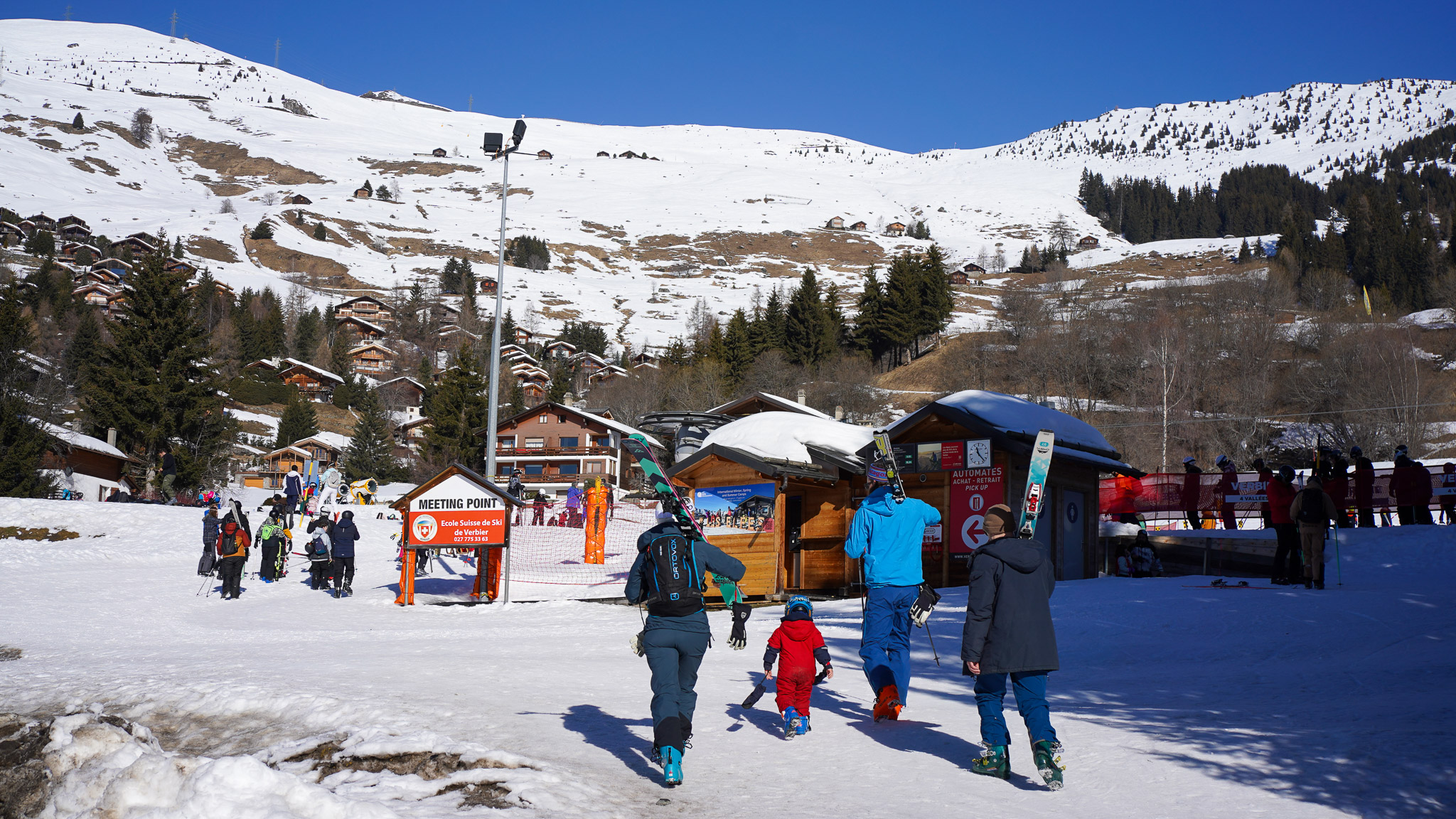
The first thing I did after arriving in Verbier – right after taking photos of the mountains, of course – was to call my ski instructor, Warren. Being the warm host he is, he immediately offers to drive me to my hotel to get changed. A professional free skier, Warren’s knowledge about skiing is beyond intimate, and as a result, I feel very comfortable around him.
Once I don my ski gear, I make my way to the ski lift we’ll be using for the next couple of days, which is about 3-4 minutes on foot (Verbier really isn’t that big). I collect my pass, and then we walk to Mountain Air, where I get fully kitted out. My feet get measured, and I get to hold ski poles to see if they are the right size for my height.
Warren says it’s absolutely critical to get the correct gear, especially for beginner skiers such as myself. A good ski instructor can only do so much if the skier’s equipment isn’t right.
“For example, if someone gets their boots fitted by a part-time shop assistant who lacks expertise, they might end up with boots that are too stiff or too wide, which can completely block their ability to improve,” Warren explains. “If the boot doesn’t flex properly or doesn’t match the skier’s biomechanics, even the best coaching won’t help.”
A good shop and instructor should check flex ratings, foot width, and overall fit because even a small mismatch can make learning much harder. Ski stiffness is another factor – if the ski is too stiff for a beginner, they won’t be able to control or bend it properly, making progress frustratingly difficult.
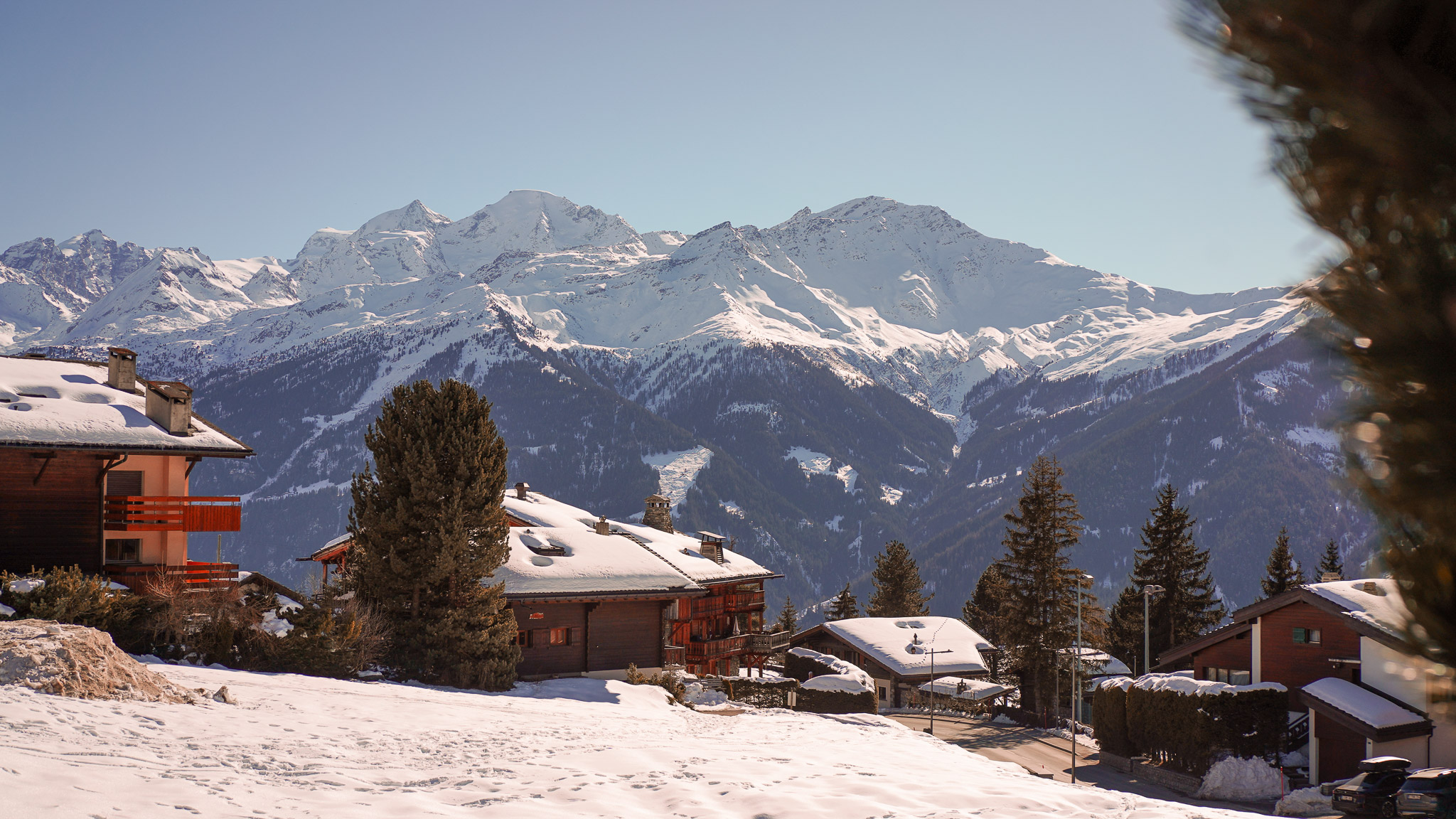
I’m given skies ideal for beginners; somewhat flexible and not too long to provide more grip on the snow. With my kit on me/ in my hand, Warren and I head over to the number 2 bus that will take us to the beginner area. Buses are free in Verbier and come very often - a nice surprise.
The sun is still shining, stronger than ever, and I have three layers of Helly Hansen gear on me, including my new favourite waterproof shell, the Sogn Tinden Jacket, which has an insulated chest pocket for phones. To be fair, the clothes do an excellent job of keeping me at an even temperature. Even so, we decide to lose the outer layers to help ventilation.
But before that, Warren walks me through the essentials – literally. The first test is to walk around with one ski on to see how it feels to be strapped in. The sensation is strange, to say the least; hobbling along like a bird, dragging along my foot with skis on.
The second step is to walk around with the skies. I follow Warren in a figure-of-eight shape, taking small steps. Trying to take a big step might result in stepping on the skies. Walking done, we head to what I call the beginner-beginner slope. I ski escalator takes you up, and you slide back down.
As Warren explains, the key to having full control over your skiing is to press your shins against the front of the ski boot as hard as you can. Don’t sit back; instead, lean forward and put as much body weight on the front as possible. This digs in the skies and lets you manoeuvre better.
“Skiers need to lean forward and put pressure on the front of their boots, especially on the outside ski when turning,” Warren explains. “This gives the ski grip and control. It feels counterintuitive initially, but once you get used to it, everything clicks into place.”
Easier said than done. My visceral self is fighting me every step of the way. The natural reaction is to lean back – surely, leaning forward will cause you to bomb it down the hill? I’m doing my best to form a snow-plough shape with my skies, but my hips and legs are getting tired. Skiing is hard!
As I’m battling with myself, I can hear Warren’s encouraging words echoing in front of me: “Good, Matt! You’re totally in control of your speed!” The speed might be glacial, but I’m very much in control of it.
After four rounds on the beginner-beginner slope, Warren suggests we catch the mini ski lift and try our luck on the other side: the beginner slope. The top of that course is steeper, and Warren guides me down so I won’t accelerate too much. My hips start aching - clearly, I’m using every muscle available, not just the ones I need. Some warm-up wouldn’t have hurt, either.
I manage to get to the bottom of the beginning slope in one piece: success! At this point, I’m parched, exhausted and ready for a break. However, I can’t resist Warren’s suggestion to go down the beginner-beginner slope once again, more or less unaided. I slide down, focusing on putting the pressure on the front and keeping the tip of the skies around 6 inches apart.
Warren cheers me on (skiing backwards and shooting a video of me) as 5-year-olds bomb it down around me like it’s nothing. I’m trying my best to remind myself that it’s natural not to be natural after an hour of skiing.
By the end of the first session, I feel confident and can’t wait for my brain to put everything I learned today into place during my sleep so I can start tomorrow’s session like a pro. For now, though, it’s time to grab some water and relax. I wish I brought my foam roller.
Day 2
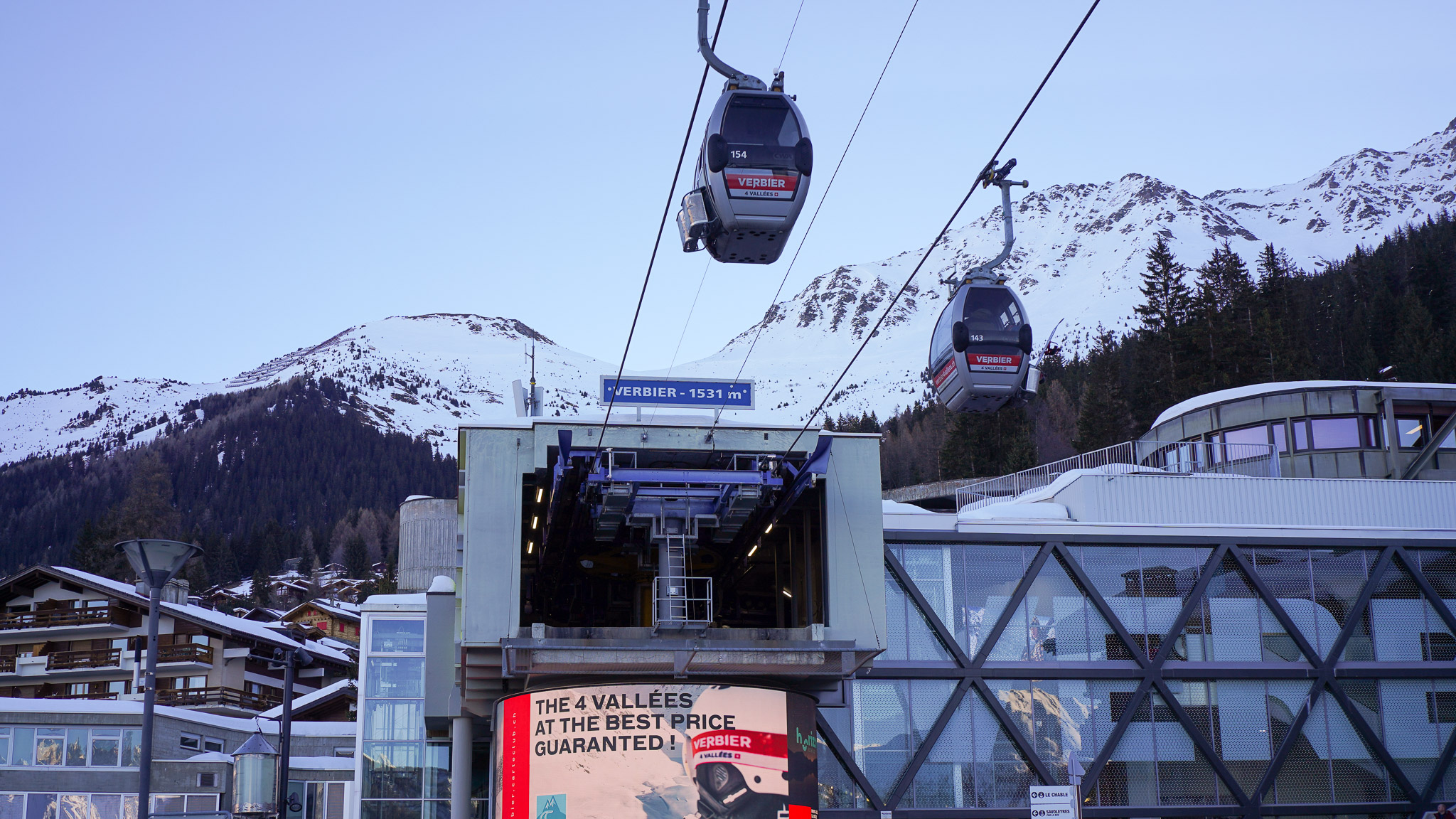
Had a comparatively good sleep, which is unusual when I’m away from home. This is probably thanks to the colder room and maybe even the fact that it was a single room with a single bed, so I didn’t feel like I was in a room designed for more than one occupant.
Breakfast was very continental, and the view from the conservatory was absolutely stunning, overlooking the mountains surrounding Verbier. Immediately filled my heart with excitement for the day ahead.
After some stretching in the room – I thought I might as well give my hips a fighting chance – I message Warren, who, naturally, is already at Mountain Air waiting for me. I put on my ski pants and jacket, grab my helmet and head out to meet him.
Once reunited with my skies and sticks, we take the number two bus to the beginner slope. It’s Thursday, and, as it turns out, it also happens to be the day when local schools take the little ones out for their ski lessons. Naturally, the slope is packed, with kids of all ages everywhere.
There are parents, too, with what look like 3-4-year olds. I love the clever technique they used to entice the kids to ski. Someone hangs up a toy on a string attached to a stick (much like a cats’ toy) and dangles it in front of the toddler to get them to move. Others use little toys the kids can throw, and once it lands, their mission is to ski to it.
I don’t need such encouragement; I’m ready to see if my brain and my body have managed to internalise yesterday’s lesson. We start on the beginner-beginner slope to see how my control is. After a couple of descends, Warren is confident I could tackle the other side (beginner slope), so we catch the ski lift, and off we go.
I feel a lot more in control than yesterday, but it’s still hard to lean onto the front of the skies like Warren wanted. We practise putting weight on the correct leg by lifting up the other one as we traverse the slope. As always, it is easier said than done, but by the second descent, I’m doing much better.
On my third attempt, I finally fall – for the first time since I started my lessons. I knew it was only a matter of time before it happened, and I’m glad it happened on the beginner slope. Even with my fiasco, Warren feels confident I could take on Le Chaux, a ‘real’ slope, albeit a blue one.
What’s a blue piste? From what Warren tells me, four colours demarcate the different gradients. Green is the least steep (the beginner-beginner slope), followed by blue, red and, finally, black. Le Chaux is a combination of mostly blue gradients with some red bits sprinkled in for good measure.
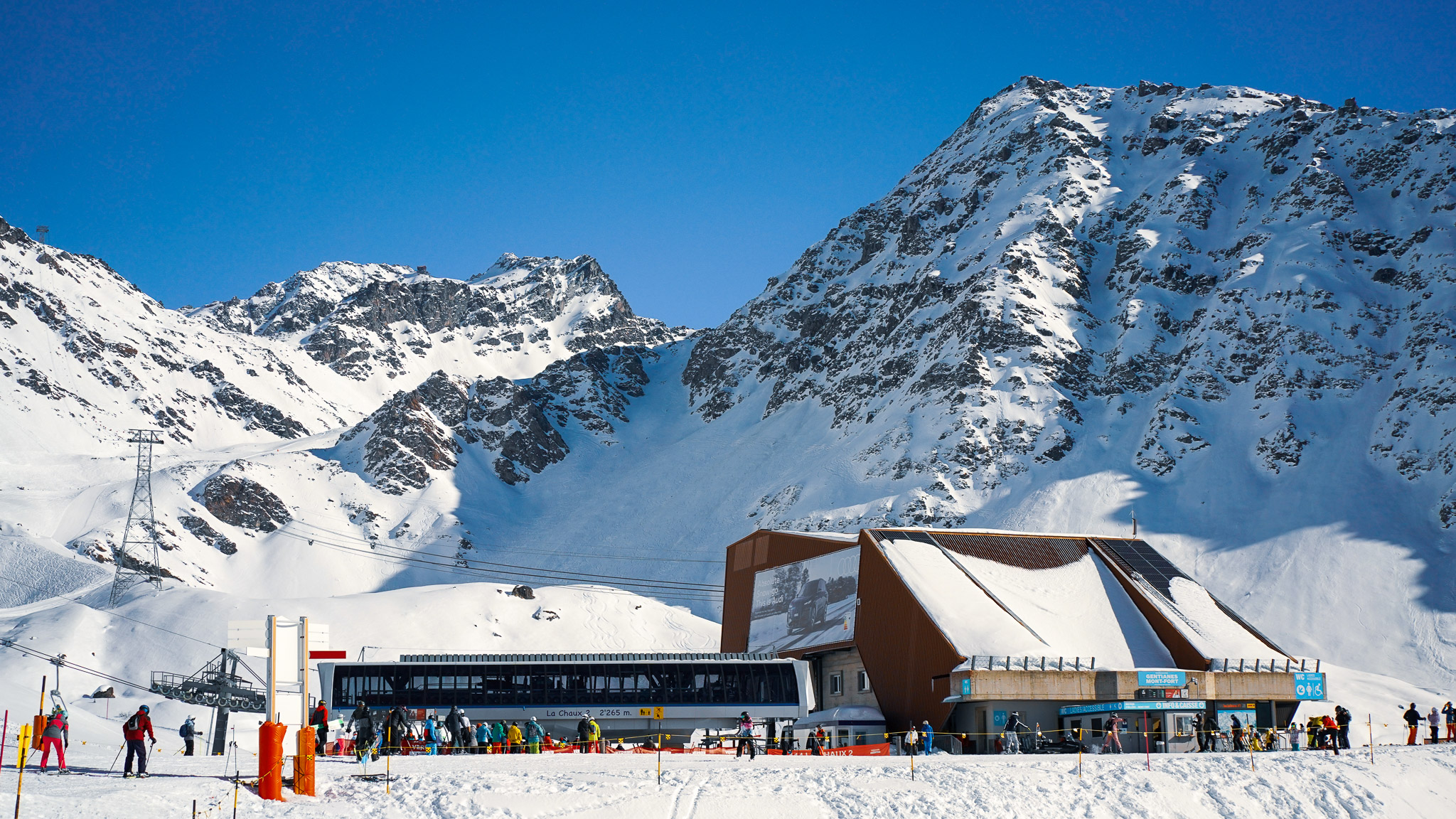
To get there, we head back to the centre to catch the gondola lift on Rue de Médran. Verbier sits around 1,530 metres above sea level; Le Chaux is all the way up 2,260 metres. You need to take two gondola lifts to reach the top, which is about half an hour. Once there, you take a third ski lift - the classic leg-dangling-in-the-air variety - to get to the start of the piste.
Looking around, I’m amazed to see the beautiful Alps that surround us – snow-capped mountains until the eyes can see. I ask Warren if he ever gets bored of the view. “Never,” he says without hesitation. I notice some spots where the snow seemingly slid down the side of the mountain and ask Warren what happened there.
“Over the last 15 years, we’ve seen a significant increase in avalanche activity due to rising temperatures,” he says. “When you have a layer of snow affected by heat, then fresh snow falls on top, the layers don’t bond well, creating unstable conditions. We’ve had weeks where temperatures swing from -15°C to +10°C overnight, which is disastrous for snowpack stability.”
His concern for mountains (and the environment, in general) made him get involved with Protect Our Winters (POW), a nonprofit dedicated to fighting climate change, specifically focusing on its impact on winter sports and mountain communities. “It’s a fantastic organisation because it’s led by athletes and outdoor enthusiasts who inspire others to take action,” adds Warren. “The goal is to promote sustainable practices, such as using trains instead of planes for travel and reducing our environmental impact.”
With my poles clutched, I start my descent. Warren is ahead of me, focusing on going as slow as I am (which must be hard, to be fair). I’m conscious of everything and afraid of going too fast and literally falling off the side of the slope. We get to the first bend, and I promptly fall on my bum as I try to turn. We’re off a good start.
We descend further still until we get to a point where the slope gets steep. This is also the area where another slope joins ours, one that’s much steeper and, therefore, has skiers bomb down on it. Warren tells me we need to go to the other side, slowly edging our way toward a blue pole that marks the other side of the slope.
I’m frantically scanning the terrain to see where it looks the least steep. I intended not to fall; I don’t want to disappoint Warren or myself. I’m very conscious of skiers going 30mph perpendicularly to where I want to go, but Warren is off, so I have to go, too. My quads are working overtime, and my mind is racing, but somehow, I make it to the other side. Happy days.
The slope continues to offer a mix of blue and steeper red gradients. Whenever we hit the red bits, we regroup, and I follow Warren across the slope. Skiers literally fly past us, but I’m busy putting pressure on the correct leg and not sliding out of control on the turns. I fall and get up (often with Warren’s help). Somehow, we get to the bottom of the piste.
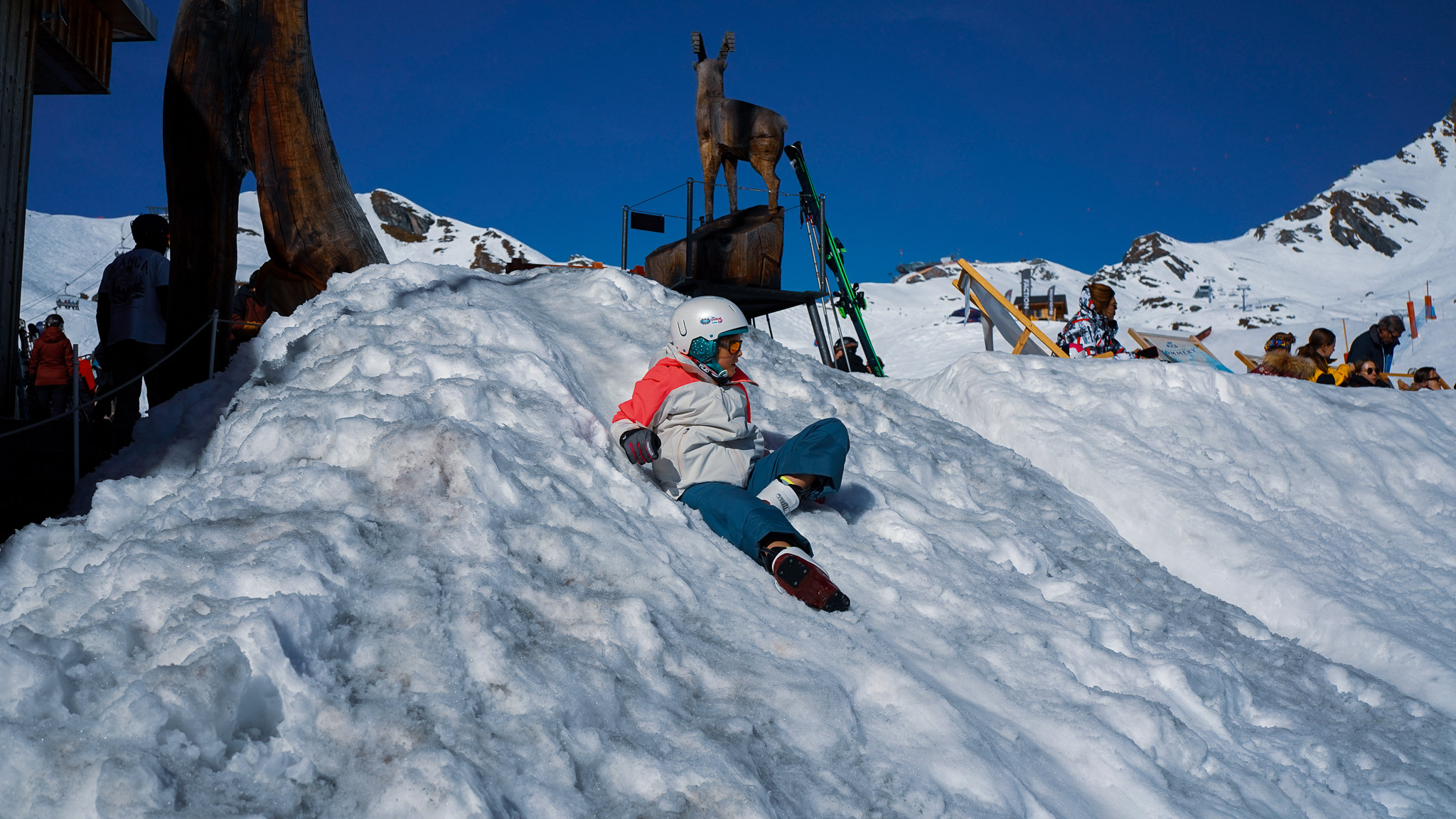
We go again. My confidence is building but every turn feels like tap dancing on high wires – not natural. I fall and get up again, but at the same time, I feel more in control of my descent. Some of the corners I take are vaguely reminiscent of parallel turns, which is the ultimate goal of my sessions in Verbier.
It’s now 12:45 pm, and we’ve been either travelling to places to ski or actually skiing since 9 am. Warren suggests we grab a bite before going again, and I gladly agree. We hoover up some sausages and fries and wash it down with a pint of peach ice tea. It’s time to go again.
We take the ski lift to the top and descend again. Maybe it’s the break we just had or the familiarity with the slope, but I feel much better. I throw myself into some corners, and I place my weight on the correct leg most of the time. I fall occasionally, but nothing too serious.
Warren feels good about things and says I should do the next descent without my poles. I don’t dare to say no, even though I can’t imagine not having them on me. Nevertheless, we catch the lift once again and off we go.
The descent is a mix of controlled turns and falls. Fatigue starts setting in, and I miss some of the turns I easily made last time. I feel more confident, but my body is not playing ball. I end up sliding down the last bit on my bum after a fall. Thankfully, it’s not the slope but the area heading to the lift, which is comparatively flat.
We hop on the lift and return to Verbier. Even though I loved every minute of it, I feel glad we’re done skiing for the day. I need a break to internalise today’s lessons. Time to get some food and maybe even a beer.
Day 3
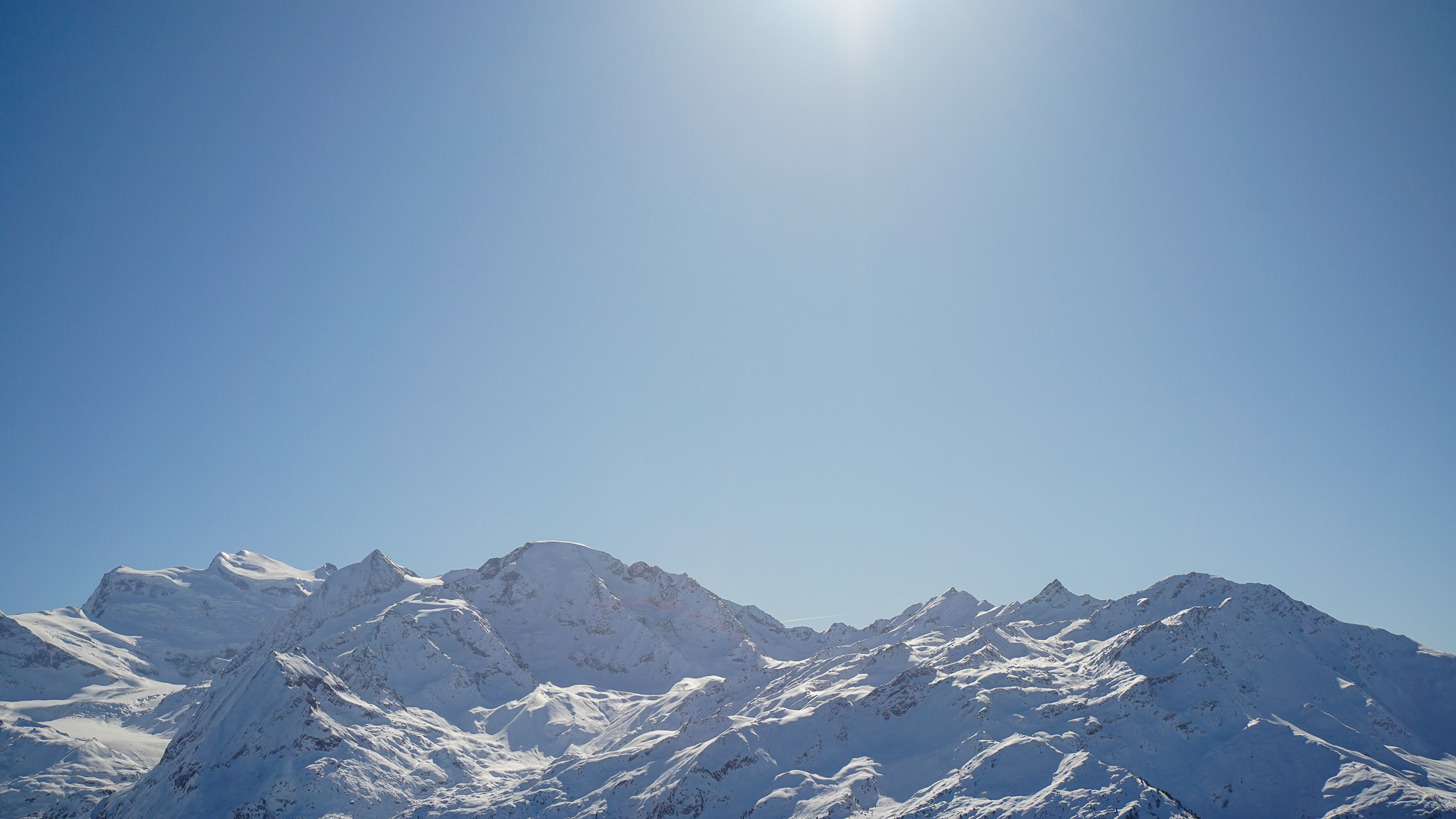
A chilly morning in Verbier; the thermometer is showing -4 degrees Celsius. I didn’t sleep well, or more like, I slept how I usually do when I’m away from home: tossing and turning in bed. My Oura Ring 4 said it took me 1h15m to fall asleep. Sounds about right.
One of the reasons why I couldn’t sleep was because I kept thinking about skiing. My mind couldn’t wait to work on what I learned until I fell asleep, so instead, it kept showing me images of me speeding out of control on the skies. My legs automatically tensed to slow me down, preventing me from falling asleep. I did some breathing exercises to calm down; then the process started again.
Despite my pre-nightmares about being unable to control the skies, I woke up feeling that I know how to parallel ski. I hadn’t done it until that point, but it felt like I might be able to do it – not sure why. After breakfast, I check out and head over to Mountain Air to meet Warren for the last time.
Ski gear collected, we head to the cable car. It’s packed; the station only opened 30 minutes prior. We make our way up, just to be confronted with even more skiers. Reams of people – many kids – are hitting the slopes, which makes navigation tricky. I clutch my poles (and do some affirmations) to ready my body and mind for parallel skiing. I feel ready for another descent.
Warren says we’ll add another move today: parallel sliding. You take up a position perpendicular to the slope and drop from the edges of the skies to the flat bottom, which makes you slide down sideways. Raising the skies to the edges stops the descent.
To my dismay, Warren immediately recommends losing the poles. It’s all in the legs, he says, and the poles will only distract you. I hesitantly say yes, even though I really want to feel the safety net the poles provide. As soon as we get off the ski lift, my skies ran out from under me, and I fall on my bum. Excellent start!
I find my way back onto my feet and catch up with Warren. He is waiting for me in the left corner, where we always meet at the top of the slope. After another easy section, I find myself face to face with the first real drop of the piste. Warren goes ahead, I steel my nerves and follow him.
After gathering some speed, I almost naturally start moving the skies into a parallel position. I’m going faster than yesterday, so turning feels better. Turning slowly felt awkward and unnatural; faster movement helps me lean into the movement better.
Warren is happy with the progression and suggests we go down Le Chaux the other way with a stepper drop at the top. I’m in his hands, so I say yes, and up we go. We practice the parallel slide, and every time it goes a little bit better. Not perfect, even by the end, but there certainly is a sense of progression.
We make five descents before 12, each time a bit quicker and in more control. I fall many times but manage to get back on the skies on my own (in most cases). Warren lets me do sections independently instead of hovering around me, instilling more confidence in me.
I’m throwing my skies left and right, constantly repeating Warren’s words: “Pressure on the front, turning to the left (or right)!” Reminding myself at every turn doesn’t magically make me a free-ride champion, but it helps me focus on the right area. I’m feeling in control and great. One might say I feel alive!
At around midday, we decide to head back down to Verbier so I wouldn’t have to rush around before leaving for the airport. My body is exhausted, and my mind is filled with unforgettable memories. I went from being unable to form the snow plough shape with my skies to skiing downhill on blue/red gradients alone. I feel fantastic.
Skiing: best sport ever?
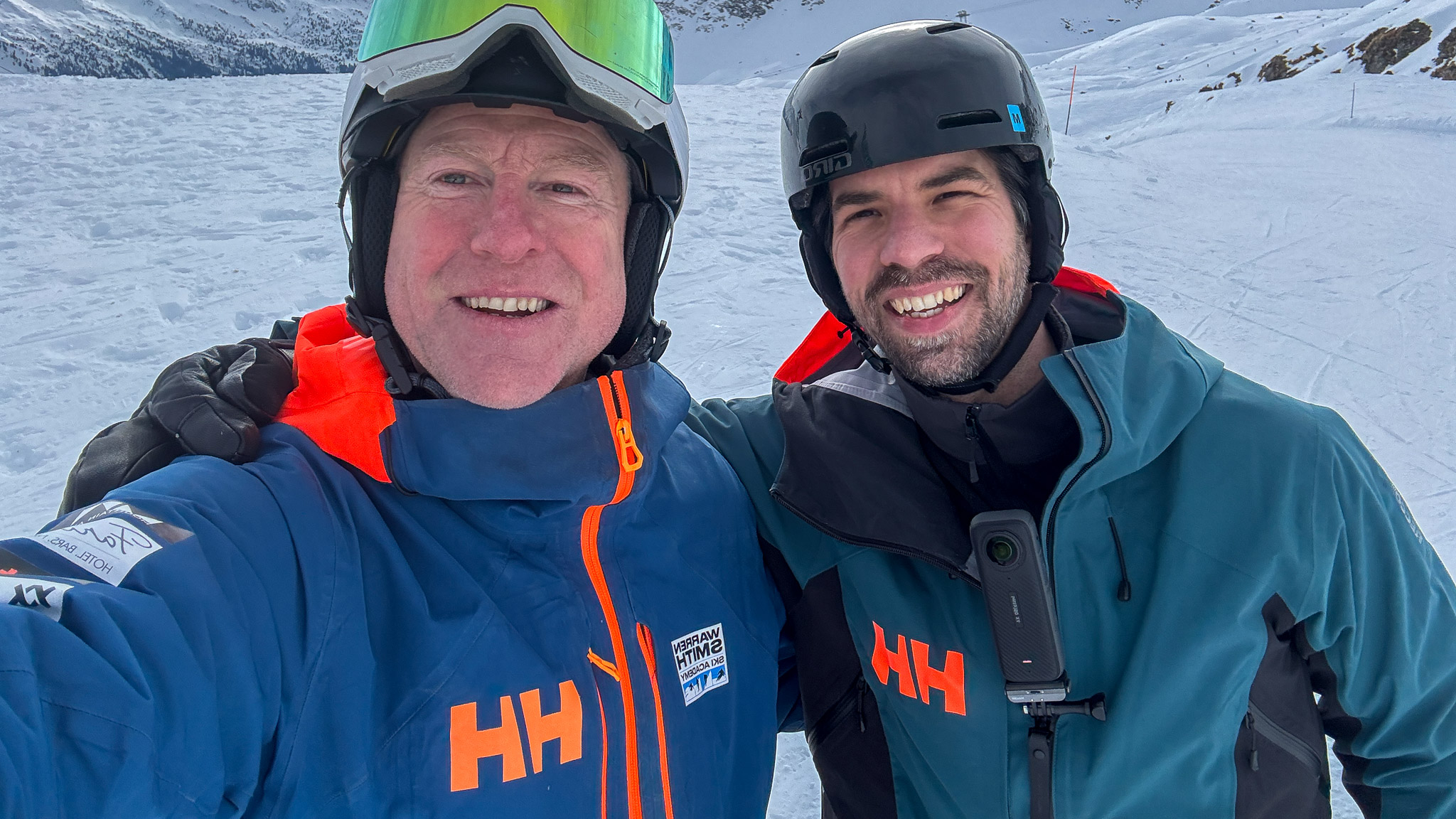
Ski instructor extraordinnaire Warren and I
Do I wish I tried skiing before? Absolutely. It’s a brilliant sport that arouses different emotions than other sports I tried before. Even as a 40-year-old, I learned the basics of skiing in a few days. I fell quite a few times in the process, but I haven’t sustained any injuries.
It’s worth noting that I’m generally active, so my body isn’t in the worst shape for exercise. I could be more flexible and muscular but don’t feel out of depth when trying new sports. People with a more sedentary lifestyle might have a different experience learning to ski.
That said, it’s never too late to start, as my experience in Verbier exemplifies (hopefully). I’m already planning on hitting the dry slopes near where I live so I can hit the piste even more confidently next year. After all, Warren learned to ski on a dry slope, and he’s a world-renowned free skier.
If you’re concerned about the money, I’ve already been suggested a few websites that can help keep costs down. I found Heidi quite intuitive, and Iglu Ski is supposed to be a good place to start planning last-minute ski trips. As for gear, I can certainly recommend Helly Hansen’s ski range. It’s top of the range, and you’ll see it everywhere on the slopes, which is reassuring.
Six biomechanical tests
The best way to learn to ski is to hit the slopes – no surprises there – but there are several ways you can ready your body for the adventure, from exercises to hitting the dry slopes. One area you should certainly pay attention to is biomechanics.
“Biomechanics plays a huge role in skiing performance, and we use a structured process to assess it,” Warren explains. At the Ski Technique Lab, they run six key biomechanical tests to understand a skier’s movement limitations. These include:
- Ankle Flex Range Test: Measures forward flex range; the national average is about 9 cm, but we aim for 15 cm for safety and 20 cm for performance.
- Ski Symmetry Test: Looks at lateral control, ensuring skiers don’t wobble when trying to keep their legs parallel.
- Leg Steering Range Test: Measures how well a skier can rotate their legs inward for turns. Many people have one side that rotates well and another that’s restricted.
- Leg Collection & Extension Test: Evaluates how well a skier flexes and extends their legs while maintaining balance.
- Core Stability Test: Ensures the core remains active while making functional movements.
- Body Angulation Test: Focuses on upper body positioning in turns, but this is usually something we address at a later stage.
“Most people don’t realise they have biomechanical imbalances until they see them in action,” he adds. Video analysis is key here – it allows skiers to see their own movement patterns and understand what they need to improve. To learn more about biomechanics, visit the Warren Smith Ski Academy website.

Matt Kollat is a journalist and content creator who works for T3.com and its magazine counterpart as an Active Editor. His areas of expertise include wearables, drones, fitness equipment, nutrition and outdoor gear. He joined T3 in 2019. His byline appears in several publications, including Techradar and Fit&Well, and more. Matt also collaborated with other content creators (e.g. Garage Gym Reviews) and judged many awards, such as the European Specialist Sports Nutrition Alliance's ESSNawards. When he isn't working out, running or cycling, you'll find him roaming the countryside and trying out new podcasting and content creation equipment.
You must confirm your public display name before commenting
Please logout and then login again, you will then be prompted to enter your display name.
-
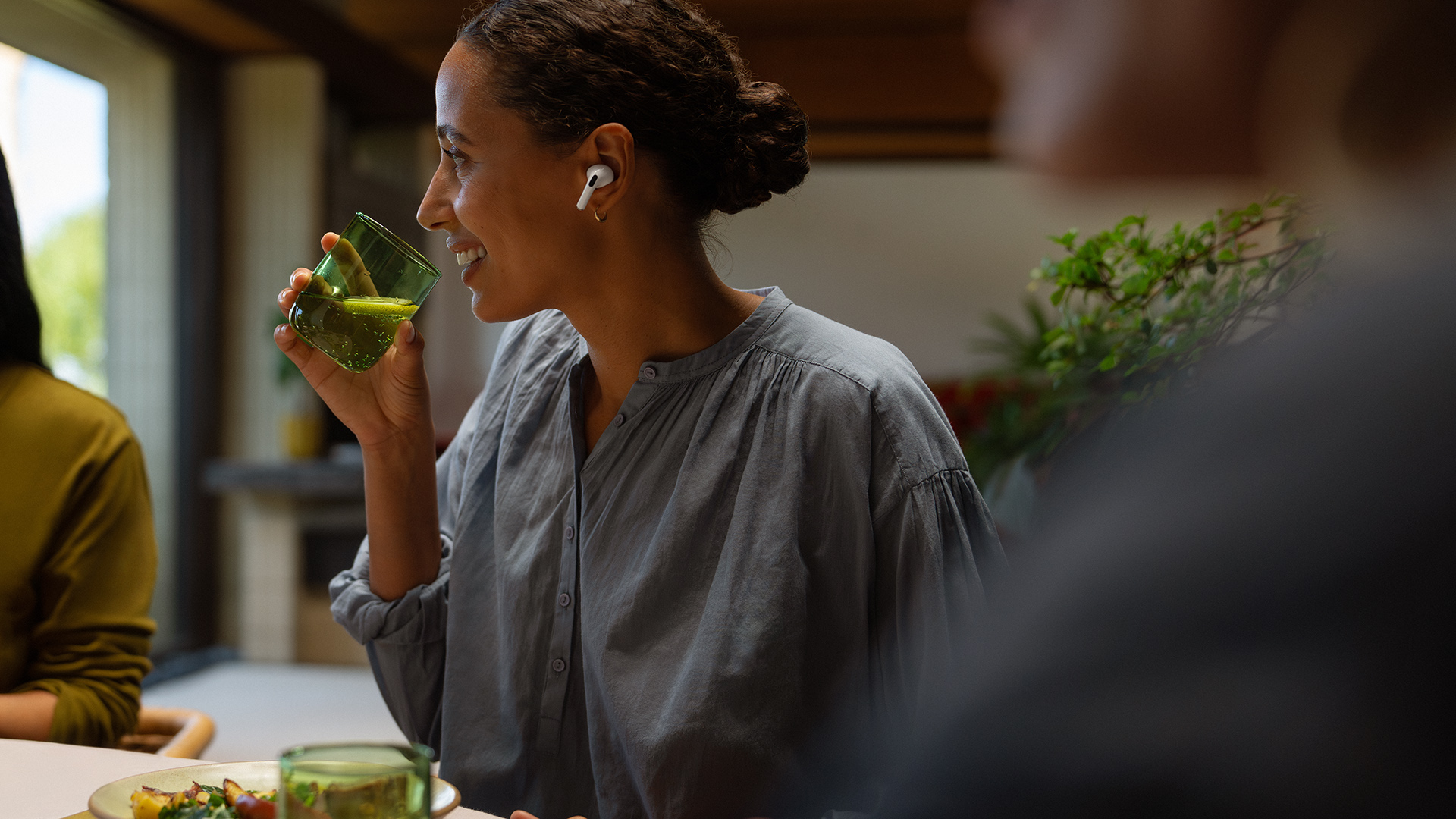 Leaked AirPods prototype looks like Nothing... literally
Leaked AirPods prototype looks like Nothing... literallyAnd we are here for them
By Britta O'Boyle Published
-
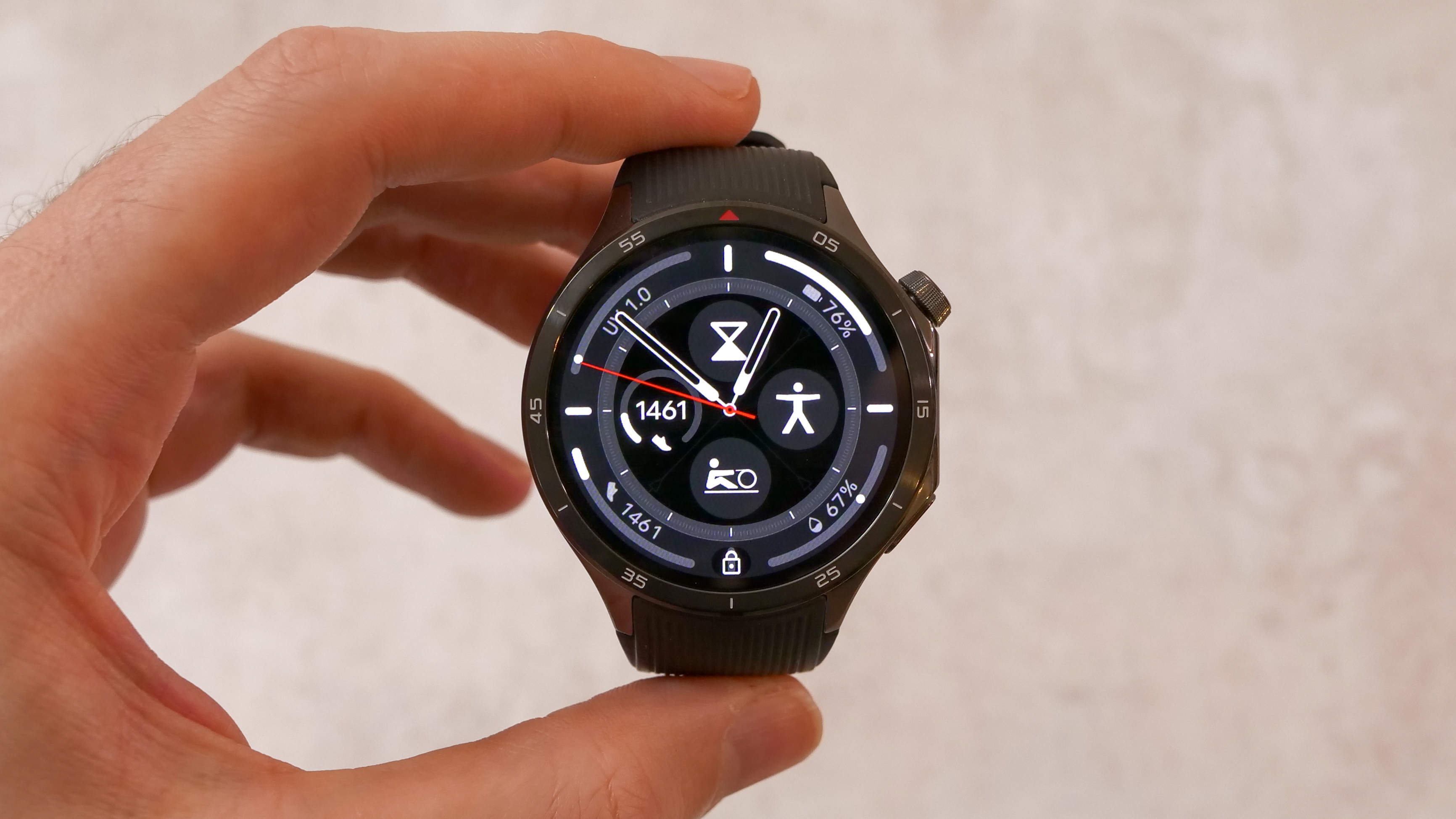 OnePlus Watch 3 lands in the UK with a flurry of freebies and a huge discount
OnePlus Watch 3 lands in the UK with a flurry of freebies and a huge discountThe new titanium-clad smartwatch brings 120-hour battery life, ECG health checks, and some serious launch offers
By Matt Kollat Published